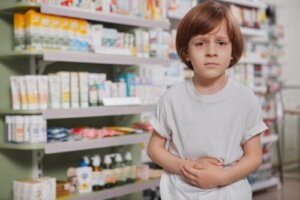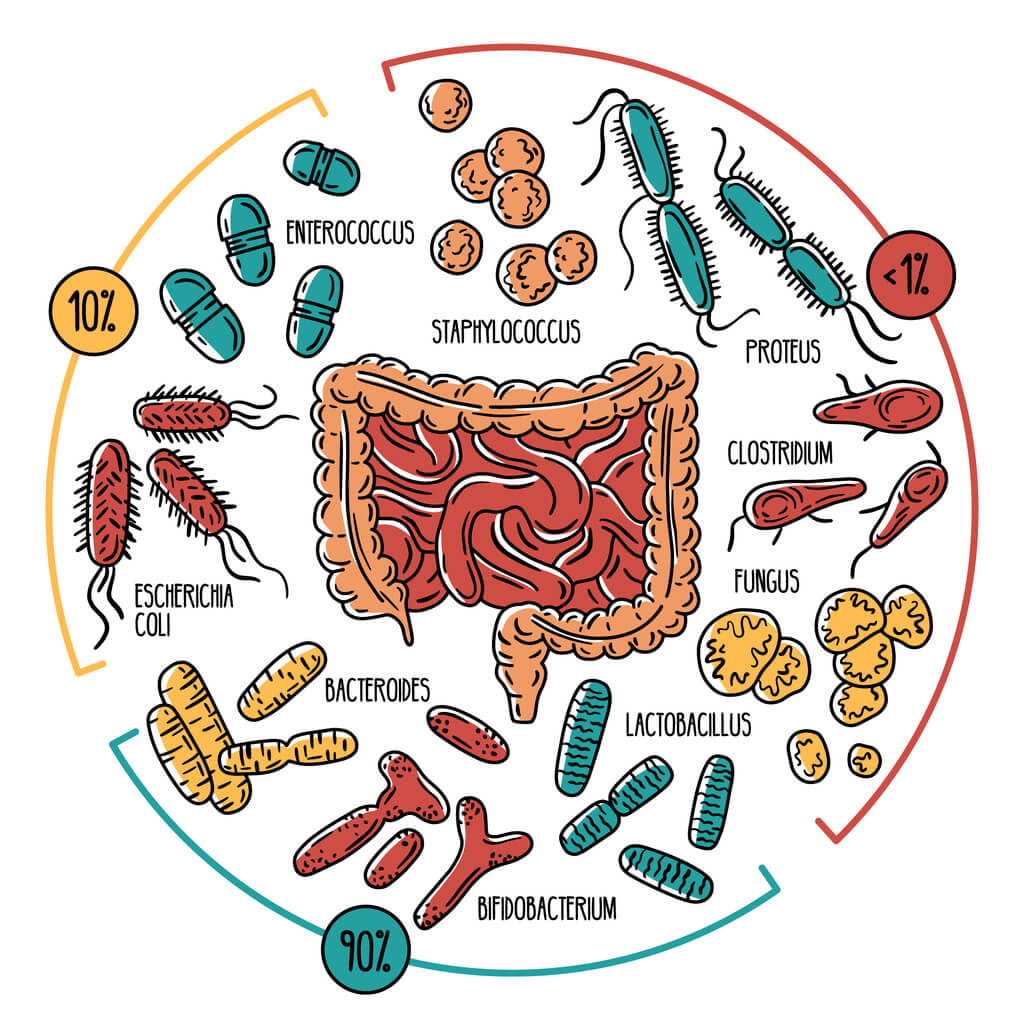Dysbiosis in Children: What It Is, Causes, and Treatment

Dysbiosis in children is a problem caused by an alteration in the microbiota of children, which occurs for various reasons and produces symptoms at the intestinal level. It can even negatively affect the absorption of nutrients and the state of body composition.
In recent years, the microbiota has begun to be considered an independent organ, which fulfills important functions in human physiology. It’s not only involved in digestive processes, but is also closely linked to the central nervous system.
In many cases, dysbiosis can be prevented and improved and this is a desirable and beneficial goal from many aspects. Learn why modifying your eating habits is so relevant.
Why does dysbiosis in children occur?
As we’ve anticipated, microbiota disease can occur for different reasons.
First of all, a reduction in the density of beneficial bacteria inhabiting the intestine should be highlighted. Under these circumstances, ideal conditions are provided for pathogenic germs to colonize the tube and disrupt its normal functioning. As a consequence, gas, inflammation, and even pain occur recurrently.
At the same time, a loss of biodiversity of the flora may occur. In general, many different species of microorganisms coexist in the intestine and are maintained in a delicate balance. However, when this stability is disrupted, as when diarrhea occurs, harmful germs proliferate uncontrollably and damage tissues. Even the absorption of nutrients and the synthesis of some vitamins can be negatively affected.
In addition to infections, there are other causes of loss of flora diversity, which occur progressively and gradually. For example, the adoption of unhealthy eating habits, including the consumption of low-quality or spoiled foodstuffs. Therefore, it’s clear that taking care of the diet is crucial to maintaining a healthy microbiota.

Antibiotics and dysbiosis in children
One of the main risk factors for the development of childhood dysbiosis is the sustained consumption of antibiotics. Many of these drugs are not selective when it comes to attacking bacteria and tend to eradicate them regardless of the organ in which they’re housed.
In the case of the microbiota, its density is considerably reduced, which favors the development of intestinal diseases, such as diarrhea. This is evidenced by research published in Brain, Behavior and immunity.
In these cases, it’s usually advisable to administer probiotics in order to prevent the beneficial bacteria from being eliminated by the antibiotic.
Thus, the side effects of the drug will be less, as well as the risks of its use, but it should still be reserved for specific cases that warrant it.
It’s important to emphasize that what we eat influences the composition of the intestinal flora, for better or worse.
We’re currently exposed to a lot of foodstuffs with a high content of preservatives, artificial additives, and trans fats. Regular consumption of these substances can affect the bacterial configuration of the gut, especially in younger organisms.
You may be interested in: 9 Foods that Should Be in Your Child’s Diet
Also, inadequate fiber intake in the diet may be another cause of the loss of bacterial density, as part of this acts as a natural prebiotic. In fact, several studies have shown that fiber nourishes the microbiota and favors the survival and functioning of these microorganisms.
For all these reasons, it’s always advisable to base the diet on the consumption of fresh foods with high nutritional density. Also, ensure an intake of at least 25 grams per day of fiber to maintain a healthy microbiota and intestinal transit in good condition.

Childhood dysbiosis, an increasingly frequent problem
Unfortunately, dysbiosis in children is increasingly observed and this increases the risk of suffering diseases with an inflammatory base, such as irritable bowel syndrome. Focusing on prevention is key and this strategy starts at home.
In the case where childhood dysbiosis has already occurred, it would be best to consult with a specialist in order to implement strategies to reverse the condition. Otherwise, the child’s symptoms will only worsen over time.
Dysbiosis in children is a problem caused by an alteration in the microbiota of children, which occurs for various reasons and produces symptoms at the intestinal level. It can even negatively affect the absorption of nutrients and the state of body composition.
In recent years, the microbiota has begun to be considered an independent organ, which fulfills important functions in human physiology. It’s not only involved in digestive processes, but is also closely linked to the central nervous system.
In many cases, dysbiosis can be prevented and improved and this is a desirable and beneficial goal from many aspects. Learn why modifying your eating habits is so relevant.
Why does dysbiosis in children occur?
As we’ve anticipated, microbiota disease can occur for different reasons.
First of all, a reduction in the density of beneficial bacteria inhabiting the intestine should be highlighted. Under these circumstances, ideal conditions are provided for pathogenic germs to colonize the tube and disrupt its normal functioning. As a consequence, gas, inflammation, and even pain occur recurrently.
At the same time, a loss of biodiversity of the flora may occur. In general, many different species of microorganisms coexist in the intestine and are maintained in a delicate balance. However, when this stability is disrupted, as when diarrhea occurs, harmful germs proliferate uncontrollably and damage tissues. Even the absorption of nutrients and the synthesis of some vitamins can be negatively affected.
In addition to infections, there are other causes of loss of flora diversity, which occur progressively and gradually. For example, the adoption of unhealthy eating habits, including the consumption of low-quality or spoiled foodstuffs. Therefore, it’s clear that taking care of the diet is crucial to maintaining a healthy microbiota.

Antibiotics and dysbiosis in children
One of the main risk factors for the development of childhood dysbiosis is the sustained consumption of antibiotics. Many of these drugs are not selective when it comes to attacking bacteria and tend to eradicate them regardless of the organ in which they’re housed.
In the case of the microbiota, its density is considerably reduced, which favors the development of intestinal diseases, such as diarrhea. This is evidenced by research published in Brain, Behavior and immunity.
In these cases, it’s usually advisable to administer probiotics in order to prevent the beneficial bacteria from being eliminated by the antibiotic.
Thus, the side effects of the drug will be less, as well as the risks of its use, but it should still be reserved for specific cases that warrant it.
It’s important to emphasize that what we eat influences the composition of the intestinal flora, for better or worse.
We’re currently exposed to a lot of foodstuffs with a high content of preservatives, artificial additives, and trans fats. Regular consumption of these substances can affect the bacterial configuration of the gut, especially in younger organisms.
You may be interested in: 9 Foods that Should Be in Your Child’s Diet
Also, inadequate fiber intake in the diet may be another cause of the loss of bacterial density, as part of this acts as a natural prebiotic. In fact, several studies have shown that fiber nourishes the microbiota and favors the survival and functioning of these microorganisms.
For all these reasons, it’s always advisable to base the diet on the consumption of fresh foods with high nutritional density. Also, ensure an intake of at least 25 grams per day of fiber to maintain a healthy microbiota and intestinal transit in good condition.

Childhood dysbiosis, an increasingly frequent problem
Unfortunately, dysbiosis in children is increasingly observed and this increases the risk of suffering diseases with an inflammatory base, such as irritable bowel syndrome. Focusing on prevention is key and this strategy starts at home.
In the case where childhood dysbiosis has already occurred, it would be best to consult with a specialist in order to implement strategies to reverse the condition. Otherwise, the child’s symptoms will only worsen over time.
All cited sources were thoroughly reviewed by our team to ensure their quality, reliability, currency, and validity. The bibliography of this article was considered reliable and of academic or scientific accuracy.
- Fröhlich EE, Farzi A, Mayerhofer R, Reichmann F, Jačan A, Wagner B, Zinser E, Bordag N, Magnes C, Fröhlich E, Kashofer K, Gorkiewicz G, Holzer P. Cognitive impairment by antibiotic-induced gut dysbiosis: Analysis of gut microbiota-brain communication. Brain Behav Immun. 2016 Aug;56:140-55. doi: 10.1016/j.bbi.2016.02.020. Epub 2016 Feb 23. PMID: 26923630; PMCID: PMC5014122.
- Simpson HL, Campbell BJ. Review article: dietary fibre-microbiota interactions. Aliment Pharmacol Ther. 2015 Jul;42(2):158-79. doi: 10.1111/apt.13248. Epub 2015 May 24. PMID: 26011307; PMCID: PMC4949558.
This text is provided for informational purposes only and does not replace consultation with a professional. If in doubt, consult your specialist.








